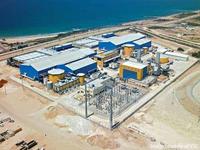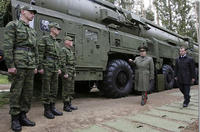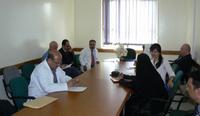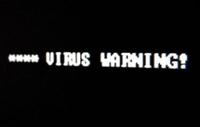-
Powerful debugging program to help U.S. nuclear deterrence
Lawrence Livermore National Laboratory (LLNL) researchers have used the Stack Trace Analysis Tool (STAT), a highly scalable, lightweight tool to debug a program running more than one million MPI processes on the IBM Blue Gene/Q (BGQ)-based Sequoia supercomputer; LLNL plans to use Sequoia’s impressive computational capability to advance understanding of fundamental physics and engineering questions that arise in the National Nuclear Security Administration’s (NNSA) program to ensure the safety, security, and effectiveness of the U.S. nuclear deterrent without testing
-
-
Twenty-year anniversary of U.S. last full-scale nuclear test
The first U.S. nuclear test, code named Trinity, took place in southern New Mexico forty-seven years earlier, on 16 July 1945; in all, the United States conducted 1,030 nuclear tests – the last one, code-named Divider, took place twenty years ago, on 23 September 1992
-
-
Radiation detection equipment installed in four Mexican ports
The Megaports Initiative is a U.S. Department of Energy program intended to enhance the ability of ports around the world to detect and interdict illicit shipments of special nuclear and other radioactive materials; Under the initiative, radiation detection gear and protocols were implemented in the Mexican ports of Manzanillo, Altamira, Lazaro Cardenas, and Veracruz, through which 92 percent of Mexico’s containerized cargo pass
-
-
Training the nuclear forensics experts of the future
Ten percent of the U.S. experts in nuclear and radiochemistry are at or nearing retirement age, according to a recent report from the National Academies of Science; meanwhile, not enough students are being trained to take their places; undergraduate summer programs in nuclear forensics and nuclear chemistry aim to replenish the ranks
-
-
New desalination technology to help solve world's water shortage

Over one-third of the world’s population already lives in areas struggling to keep up with the demand for fresh water. By 2025, that number will nearly double; a new study argues that seawater desalination should play an important role in helping combat worldwide fresh water shortages once conservation, reuse, and other methods have been exhausted
-
-
Senate to ratify New START pact today

The New START pact passed a key procedural hurdle on Tuesday when the Senate voted to bring the weapons pact between the United States and Russia to the floor of the Senate for a final vote, which is likely to be held today, Wednesday; the Senate voted 67-28 to pass a cloture motion, seemingly enough to assure final ratification; eleven Republicans joined with fifty-six Democrats to pass the cloture motion; it will take sixty-seven votes to ratify the New START pact; even if the U.S. arsenal is reduced by 30 percent, as stipulated in New START, the United States would still have 1,550 deployed strategic nuclear warheads; there are signs that these aging systems need refurbishing and modernization — and the $80 billion over ten years earmarked for this purpose is a good investment
-
-
Augmented GPS system can transmit emergency information around U.S.
Commercial global positioning systems (GPS) like those dispensing driving directions in cars can provide reliable location information to within twenty feet, while an augmented system used primarily by the Coast Guard for navigation is even more accurate; researchers say that the augmented system, called Differential GPS or DGPS, can also be used to concurrently transmit emergency messages or other relevant data for use by DHS or other government agencies
-
-
WikiLeaks: Yemen radioactive stocks "easy al-Qaeda target"

Yemeni official told U.S. diplomats that the lone sentry standing watch at Yemen’s national atomic energy commission (NAEC) storage facility had been removed from his post, and that the facility’s only closed circuit TV security camera had broken down six months previously and was never fixed; “Very little now stands between the bad guys and Yemen’s nuclear material,” the official warned, in a cable dated 9 January this year sent from the Sana’a embassy to the CIA, the FBI, and the department of homeland security; when told of the Yemeni nuclear storage problem, Matthew Bunn, a Harvard University nuclear terrorism expert, said: “Holy cow. That’s a big source. If dispersed by terrorists it could make a very nasty dirty bomb capable of contaminating a wide area”
-
-
Iran admits its nuclear facilities are under massive cyberattack

Iran has confirmed that 30,000 computers in the country’s power stations, including the nuclear reactor in Bushehr, have been attacked by the Stuxnet worm; the Stuxnet worm is described by experts as the most complex piece of malware ever designed; once Stuxnet gains access to a plant’s computers, it hunts out specific software that controls operations such as the opening and closing of valves or temperature regulation; by halting those processes it can cause extensive damage to nuclear power stations, power grids or other industrial facilities; the high number of infections in Iran have led experts to conclude that the worm may have been designed in the United States or Israel to disable Iran’s controversial nuclear facilities
-
-
Decline of species at Chernobyl linked to DNA
Brightly colored birds and birds that have a long distance migration were some of the organisms most likely to be affected by radioactive contaminants; one scientist says: “One explanation may be that these species have, for whatever reason, less capable DNA repair mechanisms”
-
-
U.S. has 5,113 strategic nuclear warheads -- down from 31,225 in 1967
IN 1967 The United States had 31,255 strategic nuclear warheads in its arsenal; in 1989, the number fell to 22,217; today, the number of warhead is 5,113; the number of non-strategic, or tactical, nuclear weapons fell by 90 percent between 1991 and 2009
-
-
Risks of laser-based uranium enrichment outweigh rewards
Researchers argue that laser-based uranium enrichment is not the way to bolster nuclear power: the technique, which involves the separation of isotopes by lasers, would save U.S. households no more than about $2 per month in energy costs, while increasing dramatically the risk of nuclear weapons proliferation
-
-
Northrop Grumman unveils latest version of Wheelbarrow UGV
Northrop Grumman’s Wheelbarrow unmanned ground vehicle (UGV) was first used by British Army bomb disposal teams during “The Troubles” in Ireland in the 1970s; since then it has gone through a number of design upgrades to extend its capabilities and meet changing military and first response needs; the company has just unveiled the latest version of this veteran robot
-
-
Uranium-mining nations ignore UN-mandated measures on nuclear terror
In the aftermath of the 9/11 terror attacks and the 2004 uncovering of the Pakistan-based A. Q. Khan nuclear smuggling network, the United States pushed Resolution 1540 through the UN, which required states to impose strict security measures on nuclear materials and report on the progress they have made in this regard; many states have not bothered to report — almost all them in Africa; especially worrisome is the situation in Niger, the Democratic Republic of the Congo, Zambia, Malawi, and the Central African Republic
-
-
Worry: gravitational force would cause nuked asteroids to reform
The only way to prevent large asteroids from hitting Earth is to use nuclear weapons to blast them to pieces; scientists find that this is not good enough: the gravitational force among the asteroids fragments would cause the asteroid to reform, “Terminator”-like, within hours
-
- All
- Regional
- Water
- Biometrics
- Borders/Immig
- Business
- Cybersecurity
- Detection
- Disasters
- Government
- Infrastructure
- International
- Public health
- Public Safety
- Communication interoperabillity
- Emergency services
- Emergency medical services
- Fire
- First response
- IEDs
- Law Enforcement
- Law Enforcement Technology
- Military technology
- Nonlethal weapons
- Nuclear weapons
- Personal protection equipment
- Police
- Notification /alert systems
- Situational awareness
- Weapons systems
- Sci-Tech
- Sector Reports
- Surveillance
- Transportation
Advertising & Marketing: advertise@newswirepubs.com
Editorial: editor@newswirepubs.com
General: info@newswirepubs.com
2010-2011 © News Wire Publications, LLC News Wire Publications, LLC
220 Old Country Road | Suite 200 | Mineola | New York | 11501
Permissions and Policies
Editorial: editor@newswirepubs.com
General: info@newswirepubs.com
2010-2011 © News Wire Publications, LLC News Wire Publications, LLC
220 Old Country Road | Suite 200 | Mineola | New York | 11501
Permissions and Policies
